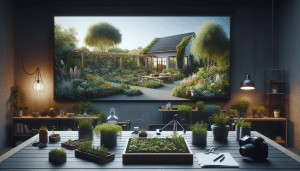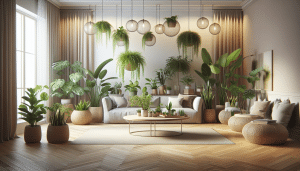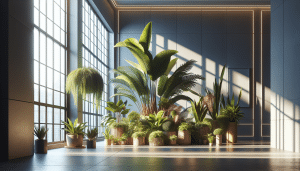Secrets That Make Your Indoor Plants Thrive
Daniel Fisher September 3, 2025
Ever wondered why some homes feel so vibrant thanks to lush indoor plants? Dive into key secrets for successful indoor gardening, including tips on lighting, soil selection, watering routines, and plant health. Transform your space while unlocking the subtle art of nurturing greenery indoors.
Lighting Choices That Change Everything
Lighting plays a vital role in promoting healthy growth for indoor plants. Without sufficient light, even the hardiest species can struggle. Some plants tolerate low-light corners, but most require some direct or indirect sunlight to flourish. South-facing windows generally provide the brightest ambient light, while east- and west-facing rooms create moderate sunlight conditions. Understanding indoor plant lighting needs is key to success. To optimize your plant health, observe how much light your space naturally receives. If necessary, supplement with artificial lights specifically designed for horticulture. These mimic the sun’s spectrum, making it easier to support flowering and foliage plants alike. Many experienced gardeners use LED grow lights to help their favorite tropical species over the darker months, as these provide a balanced energy boost without excessive heat. https://www.almanac.com/indoor-plants-beginners
The distance between plants and their light source also affects health. Placing greenery too far from the window can result in spindly growth, yellowing leaves, or a complete lack of blooms. On the other hand, direct sun right against glass panes can scorch delicate leaves, especially for moisture-loving ferns and shade-preferring varieties. Adjusting plant placement even by a few inches can produce outstanding results for both flowering and foliage plants. Observe natural cycles. Rotate containers weekly for even exposure, and shift locations seasonally as the sun’s angle changes. Don’t forget to dust leaves — cleaner foliage absorbs more usable energy.
Some indoor plant enthusiasts experiment with various window placements and artificial lighting schedules to idealize growth. This experimental approach may take patience, but it’s rewarding. If you’re designing a larger plant display or urban jungle, try grouping species with similar light requirements together. This makes care easier and prevents weaker plants from becoming overshadowed or dried out. Remember, light remains one of the most important factors that influences how indoor plants thrive, thrive or simply survive. https://www.extension.purdue.edu/extmedia/ho/ho-10-w.pdf
The Foundations: Soil and Potting Secrets
Healthy indoor plants always begin with the right soil and potting method. Not all potting mixes are created equal, and using regular garden soil indoors could cause more harm than good. High-quality houseplant soil is specially blended for excellent drainage and aeration, reducing the risk of root rot and pest infestations. It’s important to choose a potting mix formulated for the type of plant—cacti, succulents, orchids, or general foliage. Good drainage is crucial, so always use pots with holes at the base to let excess moisture escape. This simple trick can be the difference between healthy roots and an unhappy, waterlogged plant.
Some indoor gardeners add perlite, vermiculite, or even bits of orchid bark to their soil mix. These amendments improve airflow and prevent the medium from becoming compacted over time. Repotting every one to two years helps avoid nutrient depletion and root crowding. When repotting, select a pot one size larger to encourage fresh root development and a healthier plant overall. Always water your newly repotted plants lightly to help them settle and reduce stress.
The pH level of soil matters, too. While most common indoor species prefer a slightly acidic to neutral mix, others such as African violets thrive only in soils specifically pH-balanced for their needs. Always check the care tag or do quick research so you know what’s best for your favorite plant varieties. A well-chosen soil and proper potting practice truly set the stage for thriving, not merely surviving, greenery. https://hgic.clemson.edu/factsheet/growing-indoor-plants-with-success/
Watering Routines That Actually Work
Watering is where many plant parents get tripped up, but a tailored routine is essential for vibrant indoor plants. There’s no universal watering solution; different species and environments require different approaches. Plants like succulents and snake plants need long intervals between waterings, while tropical species such as ferns or peace lilies may need more consistent moisture. The key is understanding not just the species but also the humidity and temperature of your home environment.
Check soil moisture before watering. Insert your finger about an inch into the soil — if it feels dry, it’s often time to water. Overwatering is one of the most common reasons indoor plants suffer, often leading to yellowed leaves, mushy stems, or moldy surfaces. On the flip side, letting clay or peat-heavy soil dry out entirely can damage sensitive roots, so regular checks are wise. Self-watering pots and moisture meters can help busy gardeners prevent both extremes.
Seasonal changes impact indoor plant needs. In winter, plants generally require less water, thanks to lower light and slower growth. During spring and summer, you might increase watering frequency to support new leaves and flowers. Always use room-temperature water, and avoid letting plants stand in excess liquid. Drainage trays should be emptied after each watering to prevent build-up. With mindful routines, plants show their best through glossy leaves and steady growth. https://www.rhs.org.uk/houseplants/care/watering-houseplants
Humidity, Temperature, and the Microclimate Effect
One easily overlooked indoor plant secret is managing humidity and temperature for your leafy friends. Most houseplants originate from tropical or subtropical regions, preferring steady warmth and humidity. Too little moisture in the air means leaf tips could brown or curl, while too much causes rot or disease outbreaks. Identifying plant preferences lets you replicate their native habitats as closely as possible — even in a dry or centrally heated home. Pebble trays, misting bottles, and humidifiers can make big differences for humidity-loving varieties.
Temperature swings also influence indoor greenery. Placing plants close to drafty windows or heat sources like radiators may shock sensitive roots and foliage. Try to keep the temperature consistent, ideally between 65°F and 75°F for typical houseplants. Move containers away from cold glass during winter, and watch for heat stress or leaf scorch if the sun’s intensity rises in summer. Using sheer curtains to filter bright rays helps balance comfort and exposure.
Grouping plants together creates a beneficial microclimate, as their collective transpiration raises humidity in a small area. This is especially useful for maintaining health in ferns, calatheas, and other moisture-lovers. Regularly monitor microclimates, noting which parts of your home best support humidity and warmth. Simple, consistent management yields healthier, longer-living plants with fewer disease or stress indicators. https://extension.umn.edu/house-plants/growing-indoor-plants
Feeding and Fertilizing for Lush Growth
Nutrients in soil diminish over time, so responsible feeding makes a noticeable difference for thriving indoor plants. Liquid or granular fertilizers supplement key elements such as nitrogen, phosphorus, and potassium. Most species benefit from light monthly feedings during active growth periods — usually spring and summer. Too much fertilizer can harm roots, while too little results in slow growth or pale leaves. Follow product recommendations, and consider using a diluted formula for sensitive or young plants.
Specialty fertilizers exist for blooms and foliage types, as well as orchids and succulents. Choose the right product for the plant’s phase or type. Slow-release spikes or granules are a convenient option for those who wish to avoid regular feeding routines. However, it’s important to reduce or eliminate fertilizing during dormant months when plants rest. Watch for visible improvement: deeper greens, brighter flowers, and new shoots signal a well-fed plant.
Occasionally, mineral deposits may build up in pots from repeated fertilizer applications. Flushing containers with plain water every few months helps reset the soil. Look out for signs of over-fertilizing, such as leaf burn or a white crust on top of the soil, and adjust your routine accordingly. Consistent, balanced feeding empowers indoor plants to achieve their full beauty and longevity. https://gardeningsolutions.ifas.ufl.edu/care/fertilizer/fertilizing-houseplants.html
Spotting Problems Early and Solutions That Last
Proactive plant parents know the signs when something isn’t right. Early detection of pests or disease helps maintain robust indoor plants. Common issues are yellowing leaves, sudden wilting, unusual spots, or visible insects. Use a magnifying glass to inspect leaf undersides and stem joints—locations where pests like spider mites or aphids gather. Vigilance and routine checks make treatment far easier.
Managing problems starts with quarantine. Isolate affected plants to stop the spread of pests or pathogens. Remove damaged or infested leaves and gently rinse with water. Organic treatments, such as neem oil or insecticidal soap, target pests without hard chemicals. Improve airflow by spacing your plants out, which also makes pest infestations less likely. Healthy plants resist infections better, so strong basic care is your best preventive measure.
If symptoms persist, review your watering, lighting, and humidity practices — these are common sources of stress-related problems. Sometimes, an adjustment in one area solves ongoing issues. Keep your tools clean and avoid sharing soil or water between new and established plants. If a plant remains unwell, investigate specific care guides or consult with local horticulture extension services. Consistency in daily observation forms the foundation of a successful indoor plant collection. https://hgic.clemson.edu/factsheet/troubleshooting-indoor-plants/
References
1. The Old Farmer’s Almanac. (n.d.). Indoor Plants 101: A Guide to Caring for Houseplants. Retrieved from https://www.almanac.com/indoor-plants-beginners
2. Purdue University Extension. (n.d.). Lighting for Indoor Plants and Starting Seeds. Retrieved from https://www.extension.purdue.edu/extmedia/ho/ho-10-w.pdf
3. Clemson Cooperative Extension. (n.d.). Growing Indoor Plants with Success. Retrieved from https://hgic.clemson.edu/factsheet/growing-indoor-plants-with-success/
4. Royal Horticultural Society. (n.d.). Watering Houseplants. Retrieved from https://www.rhs.org.uk/houseplants/care/watering-houseplants
5. University of Minnesota Extension. (n.d.). Growing Indoor Plants. Retrieved from https://extension.umn.edu/house-plants/growing-indoor-plants
6. University of Florida IFAS Extension. (n.d.). Fertilizing Houseplants. Retrieved from https://gardeningsolutions.ifas.ufl.edu/care/fertilizer/fertilizing-houseplants.html








